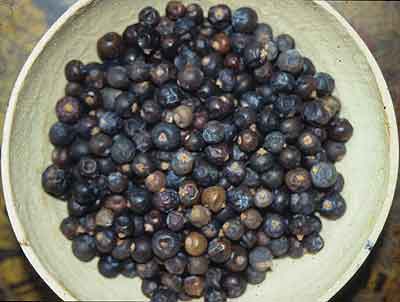All you ever wanted to know about Junipers
An illustrated talk given by Val Hawkins in Juniper Green Church Hall on April 12th, 2007 as part of the Juniper Green 300 Celebrations, being a brief overview of the origins (note the gin!), characteristics, uses, history and symbolism of the Juniper Tree.
This is a resume of the original talk.
The name of our village, apparently established by 1707, may refer either to the existence here of juniper trees, or to the local family's emblem of a juniper sprig (Lady Murray of Woodhall House). It is an emblem she shared with other Scottish clans as well as with Leonardo's sitter "Ginevra da' Benci"! Since those days we have lost most of our junipers to either grazing or modern development. Happily, junipers have now been recently planted in Dr Mackay's Wood as well as in the nearby Pentlands.
Junipers were among the first trees to regenerate after the last ice age, some 12,000 years ago, and, alongside Yew and Scots Pine, are the only conifers native to Scotland. They are among the most widespread tree genus on the planet, covering most of the Northern hemisphere from Alaska to Asia, and from the Arctic to Africa. There are between 52 and 67 species which are very varied in habit and choice of habitat. Our native is juniperus communis.
Nowadays when the plant has almost dropped out of public consciousness, except as a garden ornamental and an ingredient of gin, it is hard to imagine just how useful and important this plant was to humans, and still is to wild life. Its evergreen foliage and continually ripening berries (actually scaly cones!) provide yearlong food and shelter for birds, animals and insects, a few of whom feed on it exclusively.
Our ancestors, from the earliest times and as recently as the 19th century revered and valued it, often carrying its berries in their pockets, and using it for fuel, shelter, tools, food, medicine and toiletries. The Ancient Egyptians placed baskets of its berries in their tombs, including the tomb of Tutankhamun, both for afterlife use and as a symbol of eternal life. Its oil was used for embalming. Old Scandinavians doffed their caps to it and woe betide anyone who cut one down! It was believed to protect against witches, trolls, disease and wild animals! The smoke from its twigs was used to disinfect the air ("It driveth away all infection and corruption of the ayre") right up to the Second World War. It is probably because of its strong protective qualities that a sprig was worn by Scots soldiers in their bonnets as they went into battle.
Today we use a whole raft of cleaners, disinfectants, toothpastes, medicines and room fresheners in its place. The "Flora Danica" states "Everyone knows medicine grows on the Juniper" and Culpeper included an impressive list of disorders it could cure, some of which have since been medically proven.
It was also valued in the kitchen especially as a flavouring for fish, game and ham. Henry VIII refused to eat wild boar that had not been smoked in it. See our recipe sheet!
In the late 16th century Dr Franciscus de la Boe of the University of Leiden made the diuretic juniper berries more palatable by mixing them with other spices and aqua fortis (alcohol), thus creating the first gin! His "medicine" unsurprisingly became very popular - rather too popular as by the 1720s a quarter of London households were drunken households. This had undesirable social consequences and in the ensuing campaign to eradicate the abuse of gin, the various Gin Acts were accompanied by a plethora of propagandist art and literature, notably Hogarth's prints, Gin Lane ("Gin, Cursed Fiend with Fury fraught..") and Beer Lane ("Beer, happy produce of our Isle..), beer being seen as an antidote to gin! His success was limited and the problem remained into the 19th century when it was addressed by the Temperance Movement, one of whose supporters, the artist, George Cruikshank, like Hogarth before him, produced a suite of prints ("The Bottle" of 1847), as well as other prints and paintings on the subject showing the gradual descent into penury, murder, imprisonment and suicide allegedly resulting from gin abuse.
But the Juniper was not only associated with the grimness of urban poverty and crime. It was also used for the production of fragrant wood encased pencils, and its berries used to make the otherwise foul tasting quinine palatable, a necessary daily medicine for the administrators of the malaria ridden parts of the British Empire. This was the origin of the famous gin and tonic, one of several mixes favoured by respectable Victorian families for social drinking. The domestic uses of the Juniper proceeded apace with its introduction as a garden ornamental by Gertrude Jekyll and its reintroduction in the kitchen as part of a pickling spice.
Finally, Juniper Green, a name redolent of a kind of paradise and with a charm so obvious it has been appropriated for literary heroines, street names, a pop group (Vic and Diana Petersen) as well as an award winning organic gin. Who would live anywhere else?
Select Bibliography
Books:- Adams, R P: Junipers of the World (2004)
- Borgen, Annamarta: Urtehagen pa Knatten (1974)
- Bryant, M (ed): The Comic Cruikshank (1992)
- Culpeper: Herbal (1649)
- Flora Danica (1648)
- Jekyll, G: Wood and Garden (1899)
- Lucas, A: Ancient Egyptian Materials and Industries (4th rev ed 1962)
- Marani,Pietro : The Complete Paintings of Leonardo da Vinci (2000)
- Norman, J: Herb and Spice (2002)
- Rendle, B J: World Timbers vol 1 (1969)
- Santelmann, Kirsten: Kjerringraad for Krop og Sjel
- Wilkinson, Alix: The Garden in Ancient Egypt (1998)


